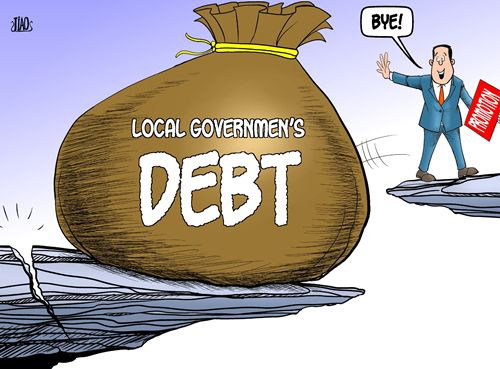QIAN PUFENG and LI SHAOJUN: Assertion about China’s debt crisis unwarranted

China will not face debt crisis.
Recently, some overseas institutions and media have claimed that China could be facing an imminent “debt crisis,” and some have argued there are parallels between its economic environment and that of the United States in 2007 prior to the subprime mortgage crisis.
However, the performance of the Chinese economy strikes a powerful counterblow toward these statements. Today, the Chinese economy is progressing while maintaining stability due to solid advancements in supply-side reform while debt levels are controllable and industrial enterprises are seeing declining debt ratios. A debt crisis is not happening and will not happen in China.
Judging from the volume and structure of China’s debt, any warnings of a debt crisis lack a foundation. For one thing, the debt levels of China’s government sectors and residents are both rather low. The debt ratio of the public sector is about 40 percent, which is well below the international warning line of 60 percent. The figures for two other major economies—Japan and the United States—are 200 percent and 120 percent, respectively. The debt ratio of Chinese residents is around 40 percent, much lower than the 80 percent average for US citizens.
Furthermore, despite the relatively high leverage ratios of China’s non-financial businesses, the risks are controllable. According to statistics from the Bank for International Settlements, the debt ratio of China’s non-financial enterprises exceeds 160 percent. This is because China has a bank-dominated financial system, and for a long time, the financing of enterprises has mainly come in the form of bank loans and other indirect financing in the expression of exterior liabilities.
Over the past few years, Chinese enterprises as a whole have experienced increased profitability, and industrial enterprises, in particular, are seeing rising returns. Though leverage ratios are relatively high, the credit and liquidity risks are declining.
Moreover, China’s foreign debt proportion is low, so it has been impacted less by the international community. In 2015, foreign debt was equal to about 13 percent of China’s GDP and 58 percent of its export profits, while the international safety lines are 20 percent and 100 percent, respectively. Currently, China’s foreign exchange reserves have reached $3 trillion, the highest in the world, while Japan comes in a distant second, with one-third as much.
The Chinese government has implemented a series of measures to prevent debt risks. For example, it has set up mechanisms for controlling debt volume as well as for preventing and handling risks. Also, it has taken various measures to manage and relieve the debt burdens of local governments.
The prevention of enterprise debt risks is stressed too. For example, the government encourages the steel and coal industries to liquidate overcapacity and enterprises to revitalize storage funds through asset securitization. Zombie enterprises are being cleaned out to optimize the allocation of resources. The government is also exploring proposals for debt-to-equity swaps, which are in accordance with rules of the market and laws, to promote debt restructuring. It also has helped to open up more channels for financing while improving multi-level systems for the financial market.
The continuous and healthy development of the Chinese economy provides a solid foundation for solving the debt problem. Since the new normal phase began, China has constantly adjusted macroeconomic control methods while the economy is improving qualitatively and becoming more efficient.
For instance, new industrial forms and financing sources are emerging while high-tech and high value-added industries are expanding. The construction of the Belt and Road continues to raise China’s status in the global value chain. The integration of Beijing, Tianjin and Hebei Province as well as the development of the Yangtze River Delta economic zone will also further optimize the spatial pattern of development.
Qian Pufeng and Li Shaojun are from the Research Office of the State Council and Renmin University of China, respectively.
